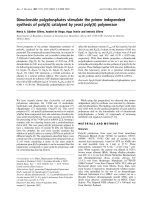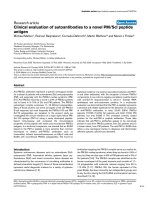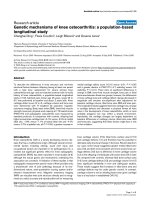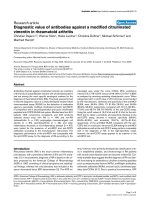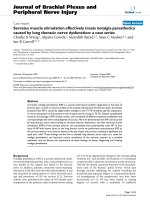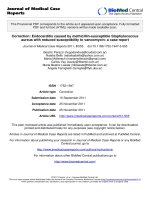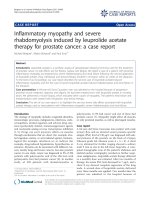Báo cáo y học: " Mucinous cystadenoma of the appendix misdiagnosed as cystic hydatid disease of the liver: a case report" docx
Bạn đang xem bản rút gọn của tài liệu. Xem và tải ngay bản đầy đủ của tài liệu tại đây (553.44 KB, 4 trang )
BioMed Central
Page 1 of 4
(page number not for citation purposes)
Journal of Medical Case Reports
Open Access
Case report
Mucinous cystadenoma of the appendix misdiagnosed as cystic
hydatid disease of the liver: a case report
Andreas Krieg
1
, Jan Schulte am Esch 2nd
1
, Ludger W Poll
2
, Stefan Braunstein
3
and Wolfram T Knoefel*
1
Address:
1
Department of General and Visceral Surgery, Heinrich Heine-University, Duesseldorf, Germany,
2
Institute of Diagnostic Radiology,
Heinrich Heine-University, Duesseldorf, Germany and
3
Institute of Pathology, Heinrich Heine-University, Duesseldorf, Germany
Email: Andreas Krieg - ; Jan Schulte am Esch - ;
Ludger W Poll - ; Stefan Braunstein - ; Wolfram T Knoefel* -
* Corresponding author
Abstract
Introduction: Primary neoplastic lesions presenting with a mucocele of the appendix are very
rare and can be divided into benign variants of mucinous adenomas or cystadenomas, mucinous
tumours of uncertain malignant potential or mucinous cystadenocarcinomas. Most of these
tumourous mucoceles are asymptomatic and are found incidentally. The major complication of
neoplastic mucinous appendiceal tumours is the development of a pseudomyxoma peritonei due
to spreading of mucin-producing cells within the abdominal cavity.
Case presentation: A 44-year-old man presented with a history of non-specific symptoms of
right upper abdominal pain. Abdominal ultrasound and computed tomography scan identified a
cystic mass consistent with the morphological characteristics of an echinococcal hydatid cyst. After
completing systemic albendazole therapy, an explorative laparotomy revealed a cystic tumour of
the appendix. Ileocaecal resection was performed and pathology reports confirmed the diagnosis
of a mucinous cystadenoma of the appendix. The postoperative course was uneventful.
Conclusion: Here we present the case of a man with a mucinous cystadenoma of the appendix
mimicking cystic hydatid disease. We discuss the importance of re-evaluation and differential
diagnostic reflections in cases of appendiceal mucocele.
Introduction
Mucocele of the appendix is a rare cystic dilatation of the
appendiceal lumen caused by mucinous secretions and
consecutive retention of mucus. It can be caused by either
non-neoplastic or primary epithelial neoplastic disease
[1,2]. The neoplastic variants are caused by mucus-pro-
ducing epithelial neoplasms including mucinous adeno-
mas or cystadenomas, mucinous tumours of uncertain
malignancy and mucinous cystadenocarcinomas [2-5].
Most of these tumours are asymptomatic and may be
found incidentally [1,2,5-7]. Others become symptomatic
because of inflammation in, for example, acute appendi-
citis or as a cause of non-specific abdominal pain [5]. A
major complication of neoplastic mucinous appendiceal
tumours is the development of pseudomyxoma peritonei,
which has a high rate of morbidity and mortality [8].
Published: 25 June 2008
Journal of Medical Case Reports 2008, 2:218 doi:10.1186/1752-1947-2-218
Received: 23 July 2007
Accepted: 25 June 2008
This article is available from: />© 2008 Krieg et al; licensee BioMed Central Ltd.
This is an Open Access article distributed under the terms of the Creative Commons Attribution License ( />),
which permits unrestricted use, distribution, and reproduction in any medium, provided the original work is properly cited.
Journal of Medical Case Reports 2008, 2:218 />Page 2 of 4
(page number not for citation purposes)
Here we report a case of a man with a mucocele caused by
a mucinous cystadenoma mimicking cystic hydatid dis-
ease and discuss the importance of differential diagnostic
reflections in cases of appendiceal mucocele.
Case presentation
A 44-year-old man presented with a history of non-spe-
cific symptoms of right upper abdominal pain for 6 years.
Abdominal ultrasound (US) revealed a cystic mass con-
taining low level internal echoes and sonic shadowing.
Computed tomography (CT) revealed, in the axial and
coronal views, a cystic mass with curvilinear calcifications
extending from segment six of the right hepatic lobe into
the right lower quadrant, consistent with the morpholog-
ical characteristics of an echinococcal hydatid cyst (Figure
1A and 1B). The patient was employed as a hunt assistant
and was exposed to dogs and foxes and their faeces. Sero-
diagnostic results for echinococcal antigens and antibod-
ies were within normal limits. A surgical resection of the
cyst by pericystectomy was planned and systemic albenda-
zole therapy was started prior to cyst evacuation. Four
weeks after systemic albendazole therapy, an exploratory
laparotomy via a right subcostal incision with extension
in the midline was performed.
During exploration of the abdominal cavity the cystic
mass, which measured 17.5 cm in length and 4.5 cm in
diameter, was identified as a cystic antecaecal appendix
with a smooth serosal surface involving the base of the
appendix (Figure 2). Due to the involvement of the
appendiceal base and the risk of perforation, we decided
against a classical appendectomy, which is recommended
in uncomplicated mucocele of the appendix, and per-
formed an ileocaecal resection with ileoascendostomy.
Intra-operatively, no peritoneal tumour implants or
ascites were conspicuous. Pathological examination
revealed a mucinous cystadenoma with a partly flat and
villous growth pattern, staining positively with periodic
acid Schiff. The nuclei were hyperchromatic with low-
grade atypia and single mitotic figures. Dystrophic calcifi-
cations were seen in areas with epithelial denudation and
extended extravasated mucin (Figure 3). The patient's
postoperative course was uneventful and annual colonos-
copy and ultrasound as follow-up were recommended
because of the potential of metachronic cancer and the
development of pseudomyxoma peritonei.
Discussion
The incidence of mucoceles of the appendix is reported to
be 0.2% to 0.3% [2]. The non-neoplastic variety is caused
Intraoperatively identified appendiceal mucoceleFigure 2
Intraoperatively identified appendiceal mucocele.
The mucocele was in the antecaecal location and on macro-
scopic assessment showed a smooth serosal surface without
peritoneal implants.
Contrast-enhanced computed tomography of the abdomen reveals a well-delineated mucinous mass with curvilinear cal-cificationFigure 1
Contrast-enhanced computed tomography of the
abdomen reveals a well-delineated mucinous mass
with curvilinear calcification. A) The axial view indicates
that the mass is located at the inferior tip of the right liver
lobe. The surrounding fat tissue does not show any fat-
stranding. B) The coronal view clearly shows the cranio-cau-
dal extension of the mass from the liver segment six to the
ileocaecal area.
Journal of Medical Case Reports 2008, 2:218 />Page 3 of 4
(page number not for citation purposes)
by an obstruction close to the base of the appendix, usu-
ally by a faecalith, resulting in the accumulation of mucus
and subsequent dilatation. The neoplastic variant is
caused by a mucinous epithelial neoplasm, such as
benign neoplasms, including mucinous adenomas or cys-
tadenomas, mucinous tumour of uncertain malignant
potential or the malignant variant of mucinous cystaden-
ocarcinoma [2-5]. Approximately 25% to 50% of mucoce-
les are asymptomatic and are found incidentally at
physical examination or during abdominal imaging or
surgery [1,2,5-7]. Other clinical manifestations include
symptoms caused by acute appendicitis or non-specific
abdominal pain [5]. In particular, malignant mucinous
cystadenocarcinoma may be symptomatic due to invasion
of adjacent organs. One major complication of neoplastic
mucinous appendiceal tumours is the development of
pseudomyxoma peritonei due to neoplastic mucus-pro-
ducing cells within the abdominal cavity [8]. These
patients may become symptomatic because of abdominal
pain, distension and palpable masses in the abdomen as
well as nausea, vomiting or fatigue. Recurrent disease
often involves the bowel surface and is associated with
intense fibrosis leading to adhesions and intestinal
obstruction, which often is the cause of death. The five-
year survival in patients with pseudomyxoma peritonei
has been reported to be 53% [8]. As there is a reported co-
incidence of mucinous appendiceal tumours and colonic
neoplasms, colonoscopy should, if possible, be per-
formed before surgical treatment as well as during follow-
up [4]. Diagnostic clues of appendiceal mucocele at
abdominal US are a round-, ovoid-, sausage-, pear- or
chicken drumstick-shaped cystic mass with a variable
intraluminal echotexture that in most cases shows low-
level internal echoes or septae. A strong echo with poste-
rior sonic shadowing, caused by dystrophic curvilinear
calcifications of the appendiceal wall as a result of chronic
inflammation, might be obvious as was seen in the case
presented here [6,7,9].
Cross sectional imaging such as CT is superior to US in the
evaluation of mucoceles of the appendix because it dem-
onstrates the topographic anatomical relationship
between the caecum and the mucocele. In addition, CT is
more sensitive than US in the detection of mural calcifica-
tions within the mucinous neoplasm. The appearance at
CT scanning is characterized by a well-encapsulated cystic
structure with either an enhancing smooth thin or thick
wall, with or without mural calcification. The detection of
mural curvilinear calcifications is highly suggestive of the
diagnosis, but is detectable in less than 50% of cases [6].
Kim et al. reported the appearance of small enhancing
nodules in the wall of mucinous cystadenocarcinomas,
which might enable differentiation between benign and
malignant mucoceles [9].
Several diseases including hydrosalpinx, ovarian cysts or
renal cysts have been reported as mimicking appendiceal
mucocele in their US and CT appearance as well as in their
uncharacteristic clinical symptoms [10,11]. To our knowl-
edge there are no reports of mucinous appendiceal neo-
plasms presenting as cystic hydatid disease of the liver.
Cystic hydatid disease, caused by Echinococcus granulosus,
has an uneven geographical distribution in Europe, pre-
senting with well-defined single or multiple cysts on CT
scan that may be uniloculated or multiloculated and
either thin or thick walled. Calcification, daughter cysts
and germinal membrane detachment may also be present.
Usually no rim enhancement is evident unless the hydatid
cyst is superinfected [12]. Cystic hydatid disease can occur
anywhere but is predominantly found in the right lobe of
the liver and may be characterized by nonspecific symp-
toms [13].
Although serodiagnosis was negative, in our case the mor-
phological appearance on CT, the localization with topo-
graphic relation to the right liver lobe and the medical
history made the diagnosis of a cystic hydatid disease
most likely. It is worth noting that the sensitivity and spe-
cificity of serodiagnostic tests for Echinococcosis have
been reported to range between 80% and 90% and there-
fore results might be negative despite hydatid disease
being present [14].
New therapeutic approaches in the treatment of hydatid
disease include percutaneous punction of the cystic
lesions followed by aspiration of the internal fluid and
Histological characteristics of the mucinous cystadenomaFigure 3
Histological characteristics of the mucinous cystade-
noma. Haematoxylin and eosin stain shows a villous growth
pattern and positive staining with periodic acid Schiff.
Publish with BioMed Central and every
scientist can read your work free of charge
"BioMed Central will be the most significant development for
disseminating the results of biomedical research in our lifetime."
Sir Paul Nurse, Cancer Research UK
Your research papers will be:
available free of charge to the entire biomedical community
peer reviewed and published immediately upon acceptance
cited in PubMed and archived on PubMed Central
yours — you keep the copyright
Submit your manuscript here:
/>BioMedcentral
Journal of Medical Case Reports 2008, 2:218 />Page 4 of 4
(page number not for citation purposes)
injection of alcohol containing solutions, and re-aspira-
tion. This so-called PAIR procedure should be repeated
several times [15]. In this reported case, as we were unable
to rule out the existence of a mucinous cystadenoma, the
PAIR procedure seemed inappropriate, as it might easily
have led to the feared major complications of pseu-
domyxoma peritonei by translocating mucus-producing
neoplastic cells within the abdominal cavity along the tra-
jectory of canula.
Conclusion
The case presented shows the importance of re-evaluation
and differential diagnostic reflections in cases of the very
rare entity of mucocele of the appendix. In particular, in
cases with high suspicion for hydatid disease but with
negative serodiagnosis, surgical exploration is recom-
mended rather than the interventionally performed PAIR
procedure.
Abbreviations
CT: computed tomography; PAIR: puncture aspiration
injection re-aspiration; US: ultrasound.
Competing interests
The authors declare that they have no competing interests.
Consent
Written informed consent was obtained from the patient
for publication of this case report and accompanying
images. A copy of the written consent is available for
review by the Editor-in-Chief of this journal.
Authors' contributions
AK and JSAE performed the surgery, conducted the acqui-
sition, analysis and interpretation of data and drafted the
manuscript, LWP performed the analysis and interpreta-
tion of the computed tomography scans, SB performed
the pathological analysis, WTK made substantial contri-
butions to the conception, acquisition and interpretation
of data and revised the manuscript critically. All authors
read and approved the final manuscript.
References
1. Connor SJ, Hanna GB, Frizelle FA: Appendiceal tumors: retro-
spective clinicopathologic analysis of appendiceal tumors
from 7,970 appendectomies. Dis Colon Rectum 1998, 41:75-80.
2. Aho AJ, Heinonen R, Lauren P: Benign and malignant mucocele
of the appendix. Histological types and prognosis. Acta Chir
Scand 1973, 139:392-400.
3. Wolff M, Ahmed N: Epithelial neoplasms of the vermiform
appendix (exclusive of carcinoid). I. Adenocarcinoma of the
appendix. Cancer 1976, 37:2493-2510.
4. Qizilbash AG: Hyperplastic (metaplastic) polyps of the appen-
dix: report of 19 cases. Arch Pathol 1974, 97:385-388.
5. Carr NJ, McCarthy WF, Sobin LH: Epithelial noncarcinoid
tumors and tumor-like lesions of the appendix. A clinico-
pathologic study of 184 patients with a multivariate analysis
of prognostic factors. Cancer 1995, 75:757-768.
6. Pickhardt PJ, Levy AD, Rohrmann CA Jr, Kende AI: Primary neo-
plasms of the appendix: radiologic spectrum of disease with
pathologic correlation. Radiographics 2003, 23:645-662.
7. Isaacs KL, Warshauer DM: Mucocele of the appendix: computed
tomographic, endoscopic, and pathologic correlation. Am J
Gastroenterol 1992, 87:787-789.
8. Hinson FL, Ambrose NS: Pseudomyxoma peritonei. Br J Surg
1998, 85:1332-1339.
9. Kim SH, Lim HK, Lee WJ, Lim JH, Byun JY: Mucocele of the appen-
dix: ultrasonographic and CT findings. Abdom Imaging 1998,
23:292-296.
10. Dragoumis K, Mikos T, Zafrakas M, Assimakopoulos E, Venizelos I,
Demertzidis H, Bontis J: Mucocele of the vermiform appendix
with sonographic appearance of an adnexal mass. Gynecol
Obstet Invest 2005, 59:162-164.
11. Parsons JK, Freeswick PD, Jarrett TW: Appendiceal cystadenoma
mimicking a cystic renal mass.
Urology 2004, 63:981-982.
12. Polat P, Kantarci M, Alper F, Suma S, Koruyucu MB, Okur A: Hydatid
disease from head to toe. Radiographics 2003, 23:475-494.
13. Tuzun M, Hekimoglu B: Pictorial essay. Various locations of
cystic and alveolar hydatid disease: CT appearances. J Comput
Assist Tomogr 2001, 25:81-87.
14. Siracusano A, Buttari B, Delunardo F, Profumo E, Margutti P, Ortona
E, Rigano R, Teggi A: Critical points in the immunodiagnosis of
cystic echinococcosis in humans. Parassitologia 2004,
46:401-403.
15. Odev K, Paksoy Y, Arslan A, Aygun E, Sahin M, Karakose S, Baykan M,
Arikoglu H, Aksoy F: Sonographically guided percutaneous
treatment of hepatic hydatid cysts: long-term results. J Clin
Ultrasound 2000, 28:469-478.
